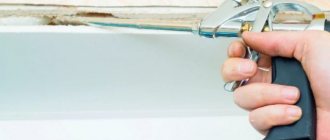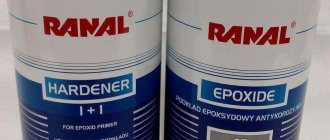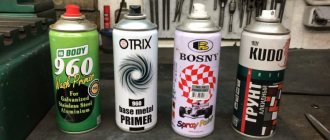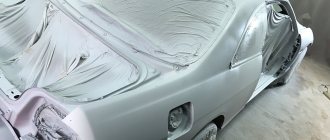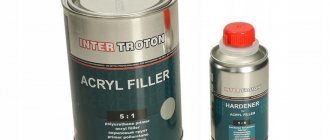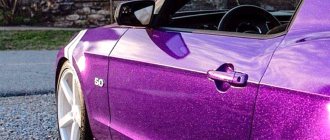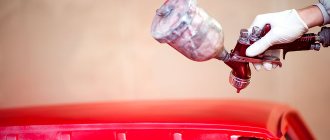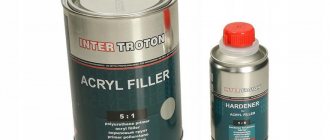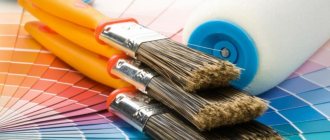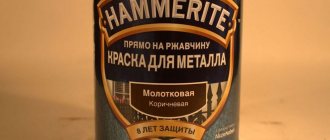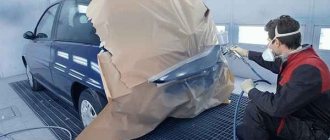Any car paintwork needs updating over time. There are often times when a car needs to be completely painted. And one of the important stages in painting the body is covering it with a primer. An auto primer is necessary for high-quality adhesion of the paintwork to the metal of the car. The second task of the primer is to hide small flaws in the car body, such as scratches and chips. The priming of the body itself is a fairly simple job, and you can do it yourself without any problems. Before starting work, it is necessary to choose the right material that will help achieve a high-quality result.
Automotive primers and their application.
Primer is a special composition that is applied to the surface of the car before applying the paintwork.
The soil has a high content of pigments. The main function of the primer is to improve adhesion (adhesion) with the subsequent layer of paintwork. When repairing a car body, they usually prime the putty repair area, which also has fragments of the old paintwork. Pure metal also needs to be primed. Thus, auto enamel is applied to the primer or to the old paintwork (provided that the old coating is compatible with the applied enamel).
Soils have different compositions and, depending on this, have different properties.
Anti-corrosion (“acid”) primer:
It is applied to clean metal and protects it from corrosion. This is a primary primer and must be coated with a secondary primer, that is, putty or paint cannot be applied to it immediately. It is always recommended to cover the “bare” metal with an anti-corrosion “acid” primer. If the metal of the new body panel is coated with high-quality factory primer, then “acidic” primer is not used.
Epoxy primer
Epoxy primer is intended for anti-corrosion protection of metal surfaces. Just like acidic soil, it is primary. For further painting of the surface, it must be covered with secondary primer. It is worth mentioning here that epoxy primer sprayed onto a flat (without minor defects) surface can be painted even without sanding paper. But this can be done before it has completely hardened, several hours after priming. If the primer has hardened, it must be treated with sanding paper and primed with acrylic primer. Then dry the acrylic primer, sand it for painting and then you can paint.
Epoxy primer contains special resins and special active additives that prevent the development of corrosion processes on the metal surface. It dries quickly and after curing becomes resistant to mechanical and temperature influences. The surface covered with this primer, even without applying paint and varnish materials, is well protected from corrosion.
Epoxy primer after application forms a dense film that does not have pores.
The disadvantage is the long drying time. At a temperature of +20 °C it averages 12 hours. An increase in drying temperature leads to uneven polymerization of soil layers and leads to the appearance of defects.
Two-component pore-filling primer:
This primer is most often used before painting a car. Porosity-filling primer can be applied in a thick layer. It fills the pores that remain on the putty, as well as the marks left by sanding paper.
However, you need to remember that the putty surface must be prepared for priming according to all the rules and the risks from sanding should not be too large. If you fill too deep scratches with this soil, then after some time, after drying, the soil will sag and all defects will be visible.
One-component nitro primer:
Apply before painting with alkyd or nitro enamels. This primer is not compatible with acrylic car enamels or metallic paints. The main advantage is that it dries very quickly.
One-component acrylic primer:
It is convenient to use as it comes in an aerosol package. But it is also sold in regular containers.
Sufficiently high quality soil. Dries quickly and is easy to use. Compatible with almost all types of paints.
Primers for plastic:
When repairing plastic, special primers are used to increase adhesion. If you are painting new plastic, then after priming with a special primer you can immediately apply paint.
Application of primer:
Before spraying, the primer must be thoroughly mixed, and in some cases, if necessary, diluted with a thinner to a working viscosity. When diluting different soils, you need to check the instructions for each specific product.
It is forbidden to dilute with solvents to the working viscosity; only thinners must be used.
Next, it is important to filter the soil.
For application, primer spray guns with a nozzle of 1.5 - 2.0 mm are usually used. Apply 1 – 2 layers. If desired, you can apply more layers, taking into account the fact that in preparation for painting, part of the primer will be sanded off. But you need to remember that it is not recommended to apply a layer that is too thick, especially since it will not dry well. Each layer must be applied after the previous one has dried. Interlayer drying time is approximately 10 – 15 minutes.
Preparing the surface for applying primer: - clean from dust; — before priming, plastic parts must be wiped with an antistatic agent; - degrease the surface.
Ground grinding:
When sanding dry before painting, use P400. When preparing with water, P800 is used. In areas of panels that have a complex shape, as well as in hard-to-reach places, you can use Brite tape.
Should I work dry or with water? Water is a source of corrosion, and some primers are designed for dry sanding only. The advantage of working with water is the absence of dust. Also convenient to use sanding paper. It clogs less and if it does clog, just rinse it with water. When working dry, you can use a sander to speed up the work. And, most importantly, the risk of corrosion is reduced.
A reasonable solution can be considered dry sanding using water in inconvenient places. Bumpers can be easily sanded with water, making sure to dry thoroughly before painting.
It is better to use a primer color similar to the color of the applied paint. This will make it easier to cover the repair area. You can also tint the primer to match the color of the paint.
A light gray color can be considered universal; it will match any paint color.
Does car primer need to be thinned?
If the primer is concentrated, which is done for ease of transportation, then diluting it is not only possible, but also necessary. This is done in the proportion indicated on the packaging. For a regular primer, it all depends on the manufacturer and the surface being treated.
Interesting materials:
How to install a fork player on a Samsung TV? How to install Forkplayer on LG? How to set a photo from gallery to the home screen? How to install a photo on your smartphone screen? How to install a photo on a Samsung a51 contact? How to set a photo as wallpaper? How to set a photo on your WhatsApp profile? How to install a photo on your laptop desktop? How to install Photoshop on Windows 10 for free? How to install gel fragrance?
Features of selection and application
If you are wondering which primer you can choose for a car and you are interested in how long it can be stored at home, then carefully study the videos presented on thematic sites.
Priming the underbody and body of the car before painting it prevents the occurrence of rust and corrosion on the surface of these parts, after which reliable adhesion and rapid “adhesion” of acrylic paint to the surface being treated is ensured. Today the market is overflowing with various products for body repair, including two-component putties, which can be epoxy or polyester.
Before using putty, prepare the surface (matt it and clean it from corrosion). At the beginning of mixing the putty, a pink hardener from a tube is added to it; its proportion should be 1:20. After this, the resulting mass must be diluted with a small spatula until a homogeneous consistency appears.
Advantages and disadvantages
Aerosol soil, like any other product, has its advantages and disadvantages. If we talk about the advantages of the spray, we can highlight the following factors:
- simplicity and ease of use;
- compactness;
- even smooth coating;
- the possibility of smooth transitions during local processing;
- lack of preliminary preparation of material for work.
Primer BLACK 400 ml aerosol
The disadvantages of the spray include 2 factors: low productivity and the ability to use only a fluid consistency. To paint the entire car, it is unlikely that you will be comfortable working with spray cans - it is troublesome, time-consuming and ineffective. It is much more rational to prepare a large container of a two-component product and use a pneumatic gun. But the aerosol is indispensable for local types of car repairs. If you are painting over a scratch, scuff or chip, the aerosol option is much more convenient. It is more efficient and will help to better process the desired area.
Sometimes liquid fluid mixtures are not suitable for treating a car body - they flow down the metal without giving the effect of a durable protective film. An aerosol auto primer will also not work for you here—you’ll have to buy viscous mixtures in cans.
Primer for cars in a can
Why are surfaces primed?
Priming is used everywhere. You can’t do without it when painting both a car and a regular floor in an apartment. It must be used when tiling walls and floors. And even when you need to paste wallpaper, the surface is first primed.
Advantages of pre-processing materials:
- Adhesion (sticking) improves and the finishing is much better.
- Deep penetration compounds reduce surface porosity. It is being strengthened.
- The service life of finishing is increasing.
- Primer can mask minor flaws.
- Since the composition’s validity period is unlimited, the surface is protected from corrosion for many years.
- The consumption of finishing material when painting is reduced.
- When added to antiseptics, the solution disinfects and destroys pests and mold.
The main types of soils used for car repairs
- Epoxy type - anti-corrosion primer for cars. This type of mixture provides an excellent protective coating for steel due to the fact that it contains high quality resins and additives. This primer can be used for various types of vehicles. Paint can be applied directly to such primer. You can use it with the wet-on-wet method. It can also be used with hardener H 5950 or H 5960 from Novol.
- Reactive anti-corrosion primer based on polyvinyl resins. It can be used on a variety of materials. This versatility is explained by excellent adhesion quality and increased corrosion resistance. The material is applied in a very thin layer, but at the same time has good resistance to environmental influences
- Acrylic primers for cars with one component. They are sprayed using a special gun. The material provides adhesion to a metal substrate; it does not have anti-adhesion properties. Mainly used for leveling surfaces. Dries quickly.
- Two-component primer contains acrylic resins. It has a high degree of viscosity and provides a large coating thickness. Masks significant defects. It has excellent adhesion properties to various materials and has a high degree of corrosion resistance. Excellent insulation of polyester putties and acrylic paints. Since a mixture of white and black is mixed, you can achieve the desired shade, and this is important when choosing paint colors.
- A one-part plastic primer can also be applied using a paint gun. It increases the adhesive properties of primers, acrylic and polyurethane varnishes.
There are primers of various colors that allow you to save paint. Acrylic types are used together with special acrylic thinners. It is important to remember that it is better to use solvents from well-known brands.
Do not forget that when carrying out body work it is necessary to use things such as a respirator and gloves, which will help minimize unpleasant phenomena.
Decorative coating and its components
The paint is easy to apply on most surfaces, providing adhesion and sufficient durability. The problem is often the inappropriate consistency of the paint product. Thick paint creates an uneven layer; in some places the saturation is excessive, while in others the original color of the body is visible. The easiest way to solve the problem is to dilute the substance. Having decided what you can use to dilute acrylic paints and take a readily available liquid for dilution, it will not be difficult to create a high-quality coating.
Acrylic paints are easy to apply on most surfaces
The paint always contains 3 main components:
- Water.
- Pigment of the corresponding color.
- Connecting substances.
The most important component is an emulsion made of polymer materials, containing acrylic. High technical and performance qualities and ease of application allowed the paint to be used in many areas. Advantages of the composition:
- suitable for various facade works;
- helps in creating the interior;
- colors various materials;
- increased resistance to ultraviolet rays, this allows the product to be used outdoors;
- durability, the material does not fade, is resistant to peeling, destruction and mechanical damage;
- affordable price. Today, acrylic is classified as a low price category; it is always preferred to save money, although its characteristics provide decent quality;
- Application does not require professional skills; a person can do the coloring on his own.
Types of primers for cars: primer, filler
To carry out body repair work, the same types of primers are used as in industrial enterprises during the production of a car. In general, there are 2 main types of mixtures:
- Primary or primer is used to protect the metal from the corrosion process and at the same time ensure reliable adhesion to the paint.
Primary primer - primer
- A secondary type of primer or filler is used to level out minor unevenness in the surface that will subsequently be painted. This allows you to create a uniform, smooth substrate. Fillers, in turn, are divided into sandable (most often used for body elements with defects that need to be hidden) and non-sandable (suitable for new and non-defective elements).
Secondary primer - filler
Today's range of formulations allows you to purchase a primer that has the properties of both a primer and a filler. For example, REOFLEX PRIMER FILLER (450-600 rubles).
Basic Concepts
Acrylic primer is a special mixture that contains acrylic and a certain amount of hardener. Depending on the number of elements, the soil can be one- or two-component.
A similar material is used to fill pores, and also as a protective layer when covering wood.
In some cases, it acts as a substrate for the main paint. The thickness of application of these solutions depends on the material being coated (50-100 microns or more). The amount of filler allows you to change the characteristics of the soil, which can be either adhesive or filling.
One of the most popular products on the market is Reoflex, which is used as a leveler. It can be applied to both wet and dry, pre-cleaned surfaces.
Dilute the mixture
Acrylic primers are component compositions. The technology of their dilution depends on this. For such purposes, experts recommend using several substances:
- The optimal thinner will be a special acrylic mixture that is compatible with a particular brand. Often, such solutions are recommended by the manufacturers of these products.
- Water. This mixture can only be used in cases where the soil contains a similar component. Water-acrylic mixtures are often diluted.
Some users recommend using a special thinner 647. But this issue is controversial, since the use of this product depends on the properties of the selected primer.
The amount of thinner often does not exceed 25% of the total volume of the mixture. Please note that it is important here to also consider the amount of hardener that is added to the solution when mixing.
You can find out the exact proportions and recommended solvent on the packaging. It is important to follow all basic recommendations to obtain high-quality and durable protection.
How to dilute acrylic primer
Many materials used in the external environment are susceptible to various factors. One of the methods of protection is to cover them with special solutions.
For such purposes, painting primers are increasingly being used, which reduce the risk of destruction or corrosion on the surface of the product. You can learn more about the characteristics of these products on specialized websites.
In what proportion to dilute the primer - example
If we consider a specific example, we can provide the following clarifying data. When it is necessary to dilute acrylic primer to cover a car body, take:
- 4 parts acrylic primer, for example, this is a 1 liter jar.
- One part of the hardener is added to it - this is 0.25 liters.
- Another 1 part of the diluent is poured in - this is also 0.25 liters. The diluent, as was already clarified above, can be water or special acrylic mixtures. It all depends on the acrylic primer itself.
Note!
It is important to understand that all the presented components, namely primer, thinner and hardener, are substances with different specific densities. That is why there can be different masses per 1 liter of composition. So, for example, soil, depending on its chemical composition, can have a mass of 1.3 to 2.8 kg in a 1-liter jar. And this also applies to the solvent and hardener. Therefore, when mixing these components for further use in body repair, it is necessary to rely specifically on volume, and not on their mass. This is the only way to obtain certain necessary properties of the final solution for creating a primer layer.
Preparing the car for priming
In order to prime a car, it is necessary to place it in a clean room with the proper level of ventilation. If you plan to apply the primer locally, then all nearby parts of the body to which the composition will not be applied must be covered with paper and secured with masking tape.
Then prepare a spray gun (spray gun) for the primer composition. It is advisable not to save on this instrument, although it will not be cheap - from about 10,000 rubles.
Depending on the volume of work, you need to choose one of two types of spray guns:
- For full priming, it is better to use a gun with a nozzle diameter of 1.8-2.0 mm. It is more versatile, and if there is no budget or other possibilities, it is better to purchase such a device.
- For partial and spot priming, a spray gun with a nozzle diameter of 1.3-1.4 mm is more suitable.
How to dilute alkyd primer?
Application: prepare the required viscosity of Body 992 anti-corrosion primer by adding 10% solvent P650 (P646) for brush application, and 25% solvent for spray application. The spray gun nozzle is 1.5 – 1.8mm. Apply in 1 medium layer to a de-greased, anti-silicone surface.
Interesting materials:
Where does water come from? Where does the water in the batteries come from? Where does liquid water come from on Earth? Where does clean water come from? Where does water come from in cities? Where does the water come from under the washing machine? Where does water come from in Rostov? Where did the problem of decreasing fresh water supplies come from? Where did the water come from? Where to get water from?
Applying acrylic primer to a car
Acrylic primer is applied to:
- fill pores;
- create a protective layer;
- slightly level the surface, giving it greater smoothness;
- create a base for the paint.
The thickness of acrylic primer application can range from 50 to more than 100 microns.
Depending on the number of elements, the primer can be one-component or two-component .
The first is applied in a thin layer and is mainly used for applying to new parts before painting. This ensures improved adhesion and rust protection.
A two-component primer is more versatile and suitable for any work on the body.
It is necessary to strictly observe the proportions when diluting the primer
In addition, only thinner is added to a one-component primer (approximately 1 part thinner to 5 parts primer). No hardener is added. In a two-component mixture, you need to first add a hardener and then a thinner (usually 1 part hardener and 1 thinner to 4 parts primer).
How to dilute automotive acrylic primer
These mixtures contain many elements. And it is from the final composition of a particular primer from a particular manufacturer that you need to select a substance that can subsequently be used to dilute the primer. There are only two best options:
- Water - but only if it is one of the components of the acrylic primer itself. The packaging should then bear the inscription “water-acrylic”. If the old primer has hardened to a solid mass, then the water needs to be heated almost to boiling water.
- Special acrylic thinners are an excellent option for thinning. It is recommended to select them of the same brand as the soil itself.
Most often it is recommended to maintain the following proportion - 4:1 with the addition of a thinner. For more detailed information, please refer to the instructions on the product label.
For example, the label of Novol Protect 300 4+1 MS primer says that for 4 parts primer you need to take 1 part hardener and 25%-35% thinner.
It is important to understand that acrylic fillers remain in an unchanged state for 30-60 minutes, which is how long after mixing they will be ready for use. This time must be taken into account when stirring the primer and applying it.
The resulting composition is applied using a spray gun. But before you fill the mixture into the device, it must be filtered (for example, through nylon or a double layer of gauze). This is done in order to cut off all large fractions that could clog the pneumatic sprayer.
How to apply filler - tips and tricks
The following sequence of actions must be followed:
- If small smudges or other minor defects have formed, then after drying they can be easily leveled by sanding.
- The primer must be applied in a thin, even layer.
In order to get the desired effect, apply 2 or 3 layers of acrylic primer. Between each application you need to wait about 20-40 minutes. At this time, evaporation of particles occurs. But you should be very careful, since the required evaporation period depends to a large extent on the ambient temperature, as well as on the thickness of the applied layer, the composition of the primer and its proportions, the type of surface being treated, and many other factors.- To achieve a uniform, smooth effect with a minimum amount of smudges formed, it is necessary to cover the surface using cross movements.
- It is the pneumatic sprayer that allows you to achieve a more even and uniform surface, compared to using a brush.
- After the last acrylic layer of primer has been applied, it is necessary to wait for 20-40 minutes first, and then increase the temperature in the room where the car is parked. This will speed up the drying time of the soil and its hardening.
- At the final stage, after complete drying, the surface is sanded. Sanding can be done mechanically or manually, and can also be done dry or wet.
How to apply primer - tips and tricks
Primers are mainly needed to enhance adhesion between the substrate and the paint. The principle of working with it is somewhat simpler:
- Before opening the primer, you need to shake it well.
- You should try to make the applied layer as thin as possible, applying a minimum amount of composition. For work, you can use a brush or swab.
- After applying the layer and before painting, you need to wait 5-10 minutes (check the packaging for the exact time) until the primer dries completely.
- Before applying paint, you need to make sure that the primer layer is smooth, even and free of any contamination.
- If the surface has pores or minimal roughness, a second coat of primer can be applied in the same way as the first.
Applying the first layer of primer
After the preparatory work, you can begin the first application of primer. The first layer can be applied with small smudges, which are subsequently corrected by sanding. In general, the initial layer should be applied to the edge of the drip, ensuring sufficient thickness and adherence to the surface.
The primer should be applied with uniform movements of the gun from a distance of 25-30 centimeters. This uses cross movements to distribute the material more evenly.
After applying the initial layer, it must be given the required time to dry. If primer with hardeners was used, the drying process will not take more than 15-20 minutes. In cases where soil is used without special additives, drying can take a very long time. Some primer mixtures take about 24 hours to dry. But they are used extremely rarely.
Preparing the car
The work must be carried out in a clean and dry garage; there should be no dust or other dirt in it. It is important that the room has good lighting and ventilation.
Once the room is ready, you can begin preparing the machine:
- it is thoroughly washed, removing all, even hard-to-reach, contaminants;
- remove old paintwork;
- those areas where corrosion has appeared must be thoroughly sanded;
- After this, the working surface is degreased using anti-silicone.
You should take care of doors and windows. All areas of the machine that are not primed must be covered with thick polyethylene or paper, securing them with masking tape to prevent the composition from getting on the rubber gaskets.
When the car is ready, you need to take care of the correct preparation of the equipment and composition for the primer.
Preparation of equipment and composition
As a rule, to prime a car on its own, its owner needs:
- the primer itself. The volume of work performed and its complexity determine whether it will be one- or two-component;
- grinding machine or sandpaper;
- alcohol to remove fat from the surface;
- if necessary, use a spray gun.
You need to dilute the primer at the very last moment, right before using it; In this case, it is necessary to strictly follow the instructions. To get rid of lumps and clots, the resulting mixture must be filtered through several layers of gauze.
Features of do-it-yourself priming
If you plan to prime the car exclusively with your own hands, then first of all you need to take care of your own protection, using a special suit. Mask and safety glasses.
The primer is carried out in several stages. The first time it is applied in a very thin layer and allowed to dry completely. The secondary layer is laid at least 2 times, each time waiting until the previous layer has completely dried.
Whether all layers have dried or not must be checked according to the instructions; it indicates how long it will take for the composition to completely harden. After this you can start sanding. It is performed either with regular sandpaper or with a special machine. After each pass, you need to remove the resulting dust, and check the result by touch - the surface of the car must be absolutely smooth, without scratches or unevenness. Only in this case will the paint lie flat and have good adhesion to the body.
Treatment
The soil can be treated either dry or with water. It should be remembered here that soils partially absorb water, which over time leads to corrosion of the metal. Therefore, it is better to process dry. A special grinding machine can help with this. Under metallic, the body should be sanded with R-600 and R-800 sandpaper. But for ordinary acrylic, R-400 and R-500 will be enough.
What to do with new parts?
New parts need to be given extra attention, because they are covered with shipping primer (usually black). In order for the repair of the machine to be of high quality, the transport soil must be cleaned with R-240 sandpaper down to the metal. After this procedure, you can put 2-3 layers of soil. And after 10-15 minutes, show it with a primer or paint of the opposite color. The next day you can clean it up. During processing, development may show minor unevenness. In this case, you will need to re-prime the flaws or the entire part.
Do-it-yourself car priming is absolutely safe if you approach it correctly. The fact is that during any paintwork, including body priming, it is necessary to use personal protective equipment (respirator, gloves, suit). Primer vapors are very harmful to the body. Therefore, be attentive to your health.
How to dilute alkyd primer?
alkyd -based paints
polymers are white spirit, solvent, turpentine, xylene, gasoline solvent Nefras-S 50/170, RS-2, as well as mixtures of these reagents.
Interesting materials:
What to do if you deleted Viber? What to do if all notes are deleted? What to do if you hit someone else's car? What to do if your reputation in Pubg has fallen? What to do if you dropped your Samsung into water? What to do if you dropped your smartphone into water? What to do if you dropped your iPhone in water? What to do if the registration certificate for your car is lost? What to do if you drown your touchscreen phone? What to do if you drown your smartphone?
Main stages of work
Briefly, the main stages of applying primer to a car will look like this:
- Prepare the car and garage for repair work.
- Stock up on the necessary tools and select a primer.
- Clean the surface from paint and rust residues, wash thoroughly and dry.
- Apply the selected primer in several layers and let them all dry thoroughly.
- Sand the body so that no scratches or irregularities are felt when touched.
- The car is ready for painting.
Immediately before you start painting the car, its surface will have to be degreased again for better adhesion to the metal.
Primer technology
Now let's take a closer look at this stage of work. First of all, you need to prepare the work area. If this is a garage, then it is desirable that it be clean, well lit, warm and have ventilation. This way, you can avoid installing additional heating sources in the form of IR heaters or the appearance of dust accumulations on the body.
The next step is to cover all untreated areas of the body where the material may get when applied with a spray gun, and also remove all plastic covers on the parts that will be repainted. Usually they cover everything with a film using masking tape, leaving only those areas of the metal surface to which the primer will be applied.
From materials and tools you will need:
- grinding machine with various replaceable abrasives.
- sandpaper.
- primer, solvent and hardener.
- spray gun and air compressor.
This is a basic set of equipment and consumables.
The next step is preparing the finished primer composition before painting the car. It is important to strictly follow the proportions indicated by the manufacturer of the material on the packaging. It is advisable to use the hardener and solvent of the same brand so that there are no problems with differences in composition. You can also use 646 as a solvent. To maintain proportions, you can use measuring containers; do not do everything by eye, especially if you are not an experienced painter. Next, the composition is filtered with special filters offered by manufacturers, otherwise you take gauze, fold it into 3 - 4 layers and run the finished primer composition through it. This is done to filter out various lumps and debris, which may subsequently clog the spray gun.
In most cases, 2 - 3 layers of primer are applied to the surface of the car body, this is enough to ensure good conditions before applying the main paint.
Many people are interested in the question: “How long does the primer dry before painting?” The answer depends on the type of material used. So, say, if a hardener is used, then a drying period of 10 - 15 minutes is allowed between layers, and the finishing layer is dried for about 18 - 20 hours. Without using a hardener, one layer of material will dry in 24 hours, but this approach is very rarely used, due to a large loss of time for work.
When choosing a primer color, people often look at the shade of the finishing paint. So, if these are light colors, then take white or combine white and the desired tone of paint. If the surface is black, then take a black tint accordingly. But there is also a universal color - this is a gray primer, it is used for surfaces of both light and dark tones.
How to dilute primer for car painting?
5 minutes to read.
Before you start painting your car, you need to apply a primer to it. A primer is a special substance that fills all the unevenness on the body, making its surface smoother. As a result, the paint adheres more firmly to the body surface, and the finish coat is often noticeably more durable, reducing the risk of rust and chipping.
Although many repair shops offer services to prepare a car for painting, this issue can be resolved without outside help. Naturally, before you start working with a primer, you should carefully prepare and consider all possible options. This article will tell you how to dilute soil for a car with your own hands.
Primer application methods
Depending on the area of the surface to be treated, you can use either an aerosol primer or a spray gun. In the first case, we are talking about quick repair of minor damage, since the composition is one-component and quite liquid, it will have to be applied at least three times.
If a large area of the body is to be treated, then it is worth using a spray gun, with which two-component compounds are used, which harden quite quickly.
Priming a car yourself is not as difficult as it might seem at first glance. For the job to be successful, it is important to prepare the car and garage, stock up on the required amount of primer, prepare the tools and act slowly.
Layering process
The first layer of primer is usually applied in a thick enough layer to evenly cover the surface, and the material itself will fill all micro-irregularities and chips. Next, let it dry for about 10 – 15 minutes. If necessary, rub problem areas and apply a second layer. They wait for it to dry a little, if all is well, then leave it for about a day and move on to the final painting.
After drying, you need to clean the surface. It is not advisable to "wet sand" as some primers absorb moisture and this process can cause rust and blistering of the paint in the future. They are usually sanded with a machine. Preparation for acrylic is done using abrasives of grades R-400 and R-500, and for metallic grades R-600 and R-800.
If you decide to paint a new part that came from the factory, then you must remove the shipping black primer using a P-240 abrasive down to the metal. Subsequently, 2–3 layers of primer are applied. After a period of 15 - 20 minutes, a developer in the form of a contrast paint is applied to the part. The next day, while sanding, you can use the developer to see minor imperfections and eliminate them by applying an additional layer of material.
It is advisable to carry out all work in protective clothing and glasses, gloves, and a respirator. To avoid paint getting into your eyes or dust into your respiratory system.
Why is the primer additionally sanded? Since this is a binding layer, it has some roughness and bumpiness, and if applied unevenly, such places can form defects in the form of sagging or smudges. You need to work very carefully with a machine or manually using sandpaper, because you will be sanding a thin layer of primer paint; if gaps appear somewhere, they can be eliminated using primer in an aerosol can and spot painting. Sand with fine-grained abrasive P800 - P1000. If there are strong flaws indicated by the developer, then they are eliminated using locally applied finishing putty and primed again, achieving an ideal surface.
Here is a video with tips on applying primer before painting a car.
Home craftsman: brief instructions for priming the car body
Primer is a mandatory process both before painting the entire car and when refreshing the paintwork on individual parts. The primer layer is intermediate between the car body and the base paint. Before priming the car, you need to carry out some preparatory work necessary to obtain a better result.
Tips for doing the job
On the Internet you can find videos and step-by-step photographs that clearly demonstrate the entire process of priming a car and applying paint yourself. In this case, a spray gun is used - a special tool used for painting various surfaces by spraying a dye.
A primer intended for processing metal and plastic, removing traces of rust, and providing anti-corrosion protection, differs in its composition and technical characteristics from primer compositions that are used for plastic or wood.
Automotive primer dries in a short period of time; it must be diluted with a solvent and hardener. It is better to adhere to the proportions indicated on the can and not try to independently choose a different ratio of components. The primer prepares the surface of metal or plastic for further painting using a spray gun and ensures high adhesion of the coating. In rare cases, the primer composition can be applied to the surface in an absolutely even layer and then wait until shrinkage occurs - a natural phenomenon that car enthusiasts encounter before painting their vehicle.
When a primer applied with a spray gun to the surface of a metal or plastic dries and begins to exhibit its rust-repellent properties, unevenness and roughness appear. After completing the work, you can compensate for these defects and make them invisible on metal and plastic by using sandpaper. You can find out how long it will take to wait for the applied composition to completely dry in the instructions for use, which are always included with the purchased primer mixture.
If the body or underbody of the vehicle is heavily corroded, then it makes sense to abandon the use of a modifier primer, since it is impossible to determine by eye how deep the rust has penetrated into the metal and then make sure that you have applied a sufficient amount of primer mixture that can transform the rust into persistent inert layer. Primers with anti-corrosion properties are never used for processing wooden parts.
Sanding the initial layer
Sanding the first layer of primer is a rather time-consuming and labor-intensive process, even with the use of a sander. However, the final result depends on the execution of this operation, so it should be treated with great responsibility and patience. Sanding the first layer is carried out with fine sandpaper until a uniform matte surface is obtained. If defective areas were identified during the work, then at this stage it is not too late to correct them using putty, which is also sanded to a perfectly smooth surface.
Particular attention is paid to areas where primer leaks have formed. They are ground to zero until a smooth surface is obtained. You should also pay attention to translucent areas. If old paint or metal protrudes from under the primer, priming will have to be repeated several times.
Layers and drying time
So, how long does it take to dry the primer mixture, which is applied to plastic parts and requires the use of a spray gun? Unlike putty, the drying time of the primer mixture is on average 30 minutes. The putty sometimes takes a long time to dry - from 24 to 48 hours. Any qualified car service worker will confirm that it is better to use several types of primer before painting a vehicle. At the beginning of painting, it is recommended to apply a phosphating primer for cars or an acid primer, after which the best “adhesion” of the surface is ensured. It should be remembered that before applying the primary primer, you will need to clean the body and underbody of the car from dirt and degrease these parts using Anti-Silicone.
Secondary primer is applied in 2 or 3 layers. The use of a pneumatic spray gun can hardly be overestimated, because it allows you to hide irregularities and scratches on the surface of the body. Sometimes auto repair shops do this work so skillfully that sanding is not required before painting the car.
It doesn’t matter whether you decide to perform operations such as puttying, priming and painting the car yourself or whether you prefer to contact a car service. You can find out how long it will take for the applied compositions to dry and which acrylic paint is best to use for painting your car by studying special literature or thematic sites on the Internet.
Before you start painting your car, you should decide on the type of paint, the technology for applying it, and expert advice. The most important thing at all stages of the work is to strictly follow the instructions and follow the recommendations of specialists.
Sources:
https://kuzov.info/grunty/ https://autokuz.ru/materiali-instrument/gruntovka-dlya-avto.html https://okuzove.ru/materialy-i-instrument/gruntovka-dlya-avtomobilya-aerozol .html https://krasimauto.com/materialy-dlya-pokraski/klassifikatsiya-gruntovok-dlya-avtomobilya-chto-nuzhno-znat.html https://avtoskill.ru/remont-obsluzhivaniye/chem-razbavit-akrilovuyu-gruntovku -dlya-avto-mozhno-li-razbavlyat-vodoy-rastvoritelem.html https://www.stroim-2014.ru/chem-razbavit-akrilovyj-grunt/ https://autobryansk.info/chem-razvesti-akrilovyj- grunt.html https://kupolnie-doma.ru/info/chem-razbavit-akrilovyj-grunt-dlja-avto/ https://chevroletcars.ru/info/chem-razbavit-akrilovyj-grunt-dlja-avto/ https ://www.em-grand.ru/post-kak-pravilno-razvesti-gruntovku-dlya-pokraski-avto.html https://krasimauto.com/pokrasochnie-raboty/gruntovka-avto-pered-pokraskoj.html
Part overview and work to be done
As mentioned earlier, today we will prime the body of the car shown in the video.
In previous episodes, we talked about how to prepare certain body elements. At the moment, the body has already been sanded with P220 sandpaper and is ready to apply protective primer.
And also all parts that should not be primed are covered with protective film. In this case, these are glass, openings, wheels and other elements that cannot be primed. This was discussed in detail in the previous part #16 of the video.
The body will be completely primed, as there were many defects in all body elements that had to be corrected and now need to be protected with primer.
A filling acrylic primer and locally an epoxy protective primer will be applied to the car body. A protective primer will be necessary because individual parts have been rubbed down to bare metal and these places need to be isolated from corrosion.
Tools and materials required for work:
In order to correctly observe the proportion of soil dilution, you can always use the annotation on the container with soil itself, where this proportion is indicated. For example, epoxy primer is diluted 1x1, and acrylic primer is diluted 1x4, as indicated on the cans of materials.
But also on the container with the materials there is always an explanation (technical instructions) on how to work with this or that soil, which is very convenient, especially for novice craftsmen who perform car repairs with their own hands.
After working with the spray gun, it is necessary to wash it with a solvent so that the soil does not remain in the channels, where it will dry out and ruin the spray gun. And also, if necessary, the instrument is cleaned from above.
A solvent will also be needed for diluting soils. In our case, this is an ordinary solvent, but according to technology, the acrylic primer must be diluted with an acrylic solvent. However, this does not matter much, it’s just that with the “native” solvent the soil dries longer. We, I repeat, will work with a regular solvent, and the material will dry faster.
First of all, we will dilute the epoxy primer, since we will need to cover the wipes down to the metal before applying the filling primer. Since there are only a few rubs, we will need about 50g of primer and 50g of hardener.
The master showed in the video how to maintain this proportion using a measuring cup, it is clearly visible.
On the container there are proportions and accordingly it is indicated how much in this case it is necessary to take the material itself, hardener and solvent, which is very convenient for work.
Preparing for priming - degreasing parts
We have sorted out the materials that we will need for the work and now we will proceed directly to priming.
The first, mandatory thing to do before starting work is to degrease all body parts. To do this, we will use anti-silicone and a paper napkin, as mentioned above.
Everything that will be primed must be thoroughly cleaned of dust, grease and small particles of debris.
Application of epoxy primer
After all body parts have been cleaned with anti-silicone, they can no longer be touched so as not to leave greasy hand marks. This may further affect the quality of the coating.
We will apply the primer with a spray gun with a 1/7 star, although it was necessary to use a spray gun with a ¼ star. But since there are few places to cover with epoxy, there is no need to dirty a second spray gun for 100 g of material. Moreover, it is not so critical.
For novice painters, it is best to use the tool that is necessary for applying primer, since they do not yet have enough experience to work with a spray gun.
But also do not forget about protective equipment and use a paint mask when working.
Since this is an epoxy primer, we apply it to the rubbed areas down to the metal. This primer has better adhesion, plus it has anti-corrosion properties, which will help the primer protect the metal from rust.
It was on this wing arch that there was an element of corrosion and an acidic primer was used. If, after applying just acrylic primer, it wears off at the end of the arch and the acidic primer “comes out,” this will affect the subsequent painting.
Epoxy primer will reliably cover areas with acidic primer, which will be much more reliable.
We will apply the same primer to problem areas of the rear window opening and at the corners of the luggage compartment opening. And also along the edges, where protective rubber seals are placed, so that pockets of corrosion do not appear there in the future.
If the body is well preserved and there was only minor local damage that was corrected, then epoxy primer is not needed; acrylic primer will do the job.
Before applying primer, you need to set up the spray gun.
For this purpose, it is equipped with special regulators:
In this case, to work, it is necessary to make such settings that there is a small pressure, a small torch and a small feed. We look at the video that the spray gun covers a small area (the problematic parts themselves) and the soil itself is laid down, very carefully without being sprayed to the sides.
The video master showed on the protective film of the rear opening exactly what kind of spray the spray gun produces when set to low pressure.
Then the opening itself, where there were problem areas, is covered with primer for subsequent reliable protection of the metal and adhesion during painting.
To avoid drips, you must always monitor the layer of applied material. And also, for example, when processing a shelf with two planes, you should try to process one plane at a time, without grabbing both sides at the same time.
Wet-on-wet primer application technology
After the epoxy primer is applied, it will need to be allowed to partially dry for about 1-2 hours (complete drying is about 12 hours or more).
After the primer has partially dried, the main filling acrylic primer will be applied using the so-called wet-on-wet technique.
Partial drying is necessary so that all the solvent evaporates from the soil and does not mix with the solvent of the next applied material. Since if it does not evaporate, then there will be a lot of solvent for the material and when applying the next primer it may simply flow.
In addition, if you do not allow the epoxy primer to dry, the drying time of which is many times longer than the acrylic primer, and you immediately apply the acrylic primer, then the latter will dry quickly, and the lower one will not have time. This will create problems when painting the body.
In addition to checking by time, you can find out that the soil has dried out by touching with your hand the edge of the adhesive tape that protects neighboring areas. If the primer on the tape does not stick to your fingers, then you can apply a second layer of primer.
Applying acrylic fill primer...
Epoxy primer was applied to all problem areas with wear to metal and others where good adhesion was needed to protect them.
Then the primer dried for about an hour and a half and it is now possible to directly apply the filling acrylic primer over it. The fact that the soil has dried can also be checked for tack, so that it does not stick to the fingers.
A bit of primer application theory...
As stated earlier, the fill primer is applied using a 1/7 star spray gun. This is due to the fact that acrylic primer is quite viscous; it is diluted to the thickness of liquid sour cream or thick milk.
Such a consistency of the filling soil is necessary to obtain a reliable layer on the surfaces to be filled. To cover the marks (after sanding P220), level the surface and for further sanding before painting.
In this case, you must follow the primer application technique.
First of all, the problem areas where the putty was applied and sanded are covered, and this area will need to be leveled. Therefore, you will need to apply a good layer of material.
Initially, primer, paint or varnish is applied to the vertical planes of the body, and only then to the horizontal ones.
This is due to the fact that when the material is applied, it is microsprayed, that is, the so-called pollination, which settles in the form of roughness on horizontal planes. When the primer is subsequently applied to horizontal parts, it covers this “pollination”, covering the roughness, simply filling it with new material.
When the material is applied to a horizontal plane, the resulting “spray” falls on the fresh paint and simply dissolves in it.
The material must be applied from top to bottom so that the “spray” is well covered.
About preparing a spray gun with a 1/7 star...
Before applying fill primer, you must also set up the spray gun for operation. A little pressure is given and the torch is medium, that is, the torch control knob is turned to the middle position.
Primer application procedure
After applying the first layer, drying between layers is allowed for about 10 minutes. Visually, when the primer has become partially matte upon drying, it becomes possible to apply a second, wetter layer. Next, we also let the second layer dry and apply a third layer, which already covers the entire part.
So, let's start priming. Let's go from top to bottom. We apply the first stripe, then the second overlaps the first and so on.
After applying the first layer, it is clearly visible that it did not completely cover the treated areas, as the putty is visible in some places. We wait for the first layer to dry and cover it with the second.
The second layer is also applied with emphasis on damaged surfaces that have been puttied with auto putty. The next layer is applied to the entire part.
We look at the priming - the puttied part of the door, spray prime the required part.
The master first primes all problem areas with the first layer of primer, according to the material application technology described above.
Can primers be diluted with water?
Most primer mixtures are sold ready-to-use. Just stir well and you can apply. ... To answer this question, you need to know the composition of the substances in the mixture, as well as what kind of solvent (diluent) should be used. For example, a water-dispersion mixture is usually diluted with water.
Interesting materials:
What pressure should there be to catch fish? What pressure should Bridgestone tires have? What is the pressure in space? What kind of bottom should a baby crib have? What should be the battery voltage on the tablet? What physical quality does cross training develop? Which country in Africa is the smallest in area? Which state was included in the Department of Internal Affairs? Which sulfur compound exhibits only reducing properties? What is the best coffee in coffee shops?
